It often feels like the only way to make savings with agricultural tyres is to negotiate cheaper tyres from your dealer. Think again! The savings you make on their purchase are nothing like what you could save over years of daily use.
Since your tyre is an essential part of your vehicle, establishing the only contact between the ground and your tractor, it is far more important than you think and the different technical parts which it affects may change everything in the results of your activity: it can save you time thanks to better traction and less slippage, it can save you fuel, help preserve your soils and therefore your yields. Not to mention savings on the mechanical wear of your tractor and tilling implements…
By choosing tyres that are more suitable to the actual use you make of them, technological tyres or simply by changing your habits, you can really begin to make savings which will be clearly visible at the end of the year.
In this article, we discuss all the important technical elements that you really must know about your tyres if you wish to improve your productivity:
1. Tyres that are designed to improve traction
Without changing your current tractor, you can capitalise more from its engine power if you have better traction. It’s your tyres’ direct role to optimise traction because they are the principal relay of engine power to the ground.
To limit the inevitable phenomenon of slippage and get a better grip on the ground, it’s always best to opt for high quality agricultural tyres which have been designed to optimise traction.

What makes the difference in terms of obtaining maximum tractive force?
- The design of the lugs or studs is generally different for each tyre manufacturer. It may be the fruit of several years of research and development and tests which have led to the optimal design.
The angle of inclination of the lugs compared to the direction of travel is certainly the most important; for optimal traction the lugs must be perpendicular to the rolling direction, like for caterpillar tracks for example. However, this form would lead to high levels of vibration when driving, considerable soil disturbance and a risk of slipping when the tractor is on a slope. On the other hand, lugs situated more in the wheel’s travel direction offer a very low level of vibration but also very little traction.
The best adapted design is generally a rounded lug, more in the axis of the wheel in the centre of the tyre to ensure stability and more perpendicular at the level of the shoulder to improve traction.
- The height of the lugs is also a decisive element: the deeper the lug, the more the traction capacity increases. However, the number and height of the lugs is always in relation to the size of the tyre.
- The angle of the leading face of the lug must be shaped to allow good penetration into the soil and to retransmit the horizontal push to the ground, avoiding the “shovel” effect which lifts up the soil and damages the ground more.
Often, when choosing a discount tyre model whose lug angle has not been studied in-depth, you will not obtain good traction and the tyre’s self-cleaning capacities may be reduced.
Don’t forget that without good slippage rate control you will lose a lot of time, increase fuel consumption and wear out your tyres more rapidly.
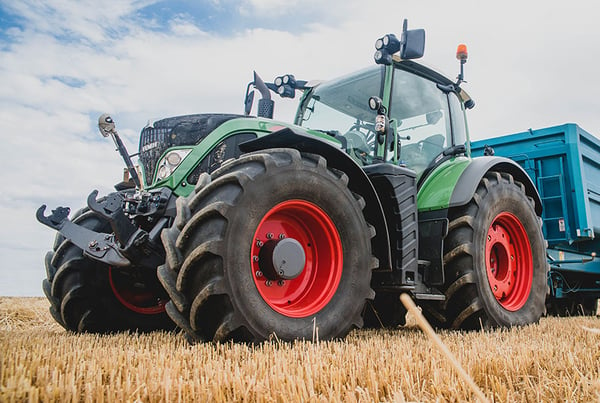 Maxi Traction IF agricultural tyres
Maxi Traction IF agricultural tyres
Choosing IF (Improved Flexion) technology tyres designed with more resistant materials allows you to use variations in pressure to improve traction.
IF agricultural tyres have reinforced sidewalls to obtain greater flexion, which means that they can work at very low pressure and therefore increase their contact patch with the ground. The lugs are perfectly applied to the ground and all the engine power can be used for traction.
FIRESTONE’s IF tyres have a multi-angle, curved lug pattern to ensure maximum self-cleaning. They enable soil preservation by reducing compaction while optimising tractive force to save time during tilling.
2. Better traction with duals
Of the different solutions to improve your vehicle’s traction, the use of dual wheels is the most efficient alternative.
This technique allows you first and foremost to obtain an excellent distribution of the load while reducing tyre pressure, thus considerably limiting the risks of soil compaction.
Basically speaking, dual agricultural tyres allow you to increase the size and the weight of the implements used, to improve your engine’s tractive power considerably, while reducing the slippage rate and impact on the ground.
This technique increases the rolling surface in contact with the ground by increasing the number of lugs which grip into the soil, which leads to better traction, but also has many other benefits:
- Time saving
- More weight (bigger, heavier implements)
- Efficiency and productivity gains
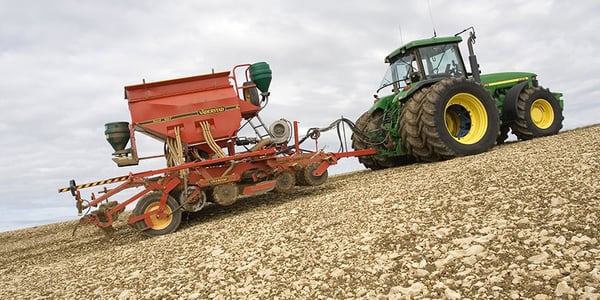 Dual wheels for a very powerful tractor
Dual wheels for a very powerful tractor
Duals are particularly recommended for very powerful tractors and large surface areas.
While this option has benefits, there are also limitations. You cannot choose any old tyre; duals must be of:
- the same category,
- the same structure,
- where possible the same brand,
- with an equivalent level of wear.
All these constraints may represent a high cost, without mentioning the problem linked to the width of the vehicle when driving on the road.
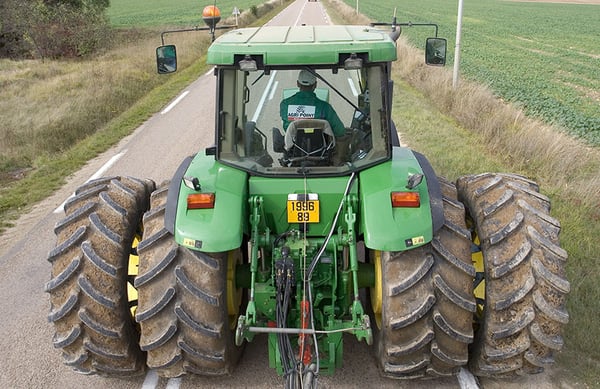 Dual agricultural tyres on the road
Dual agricultural tyres on the road
3. Tyres which limit slippage to save time
What type of tyre can you use to reduce the slippage rate and save time?
This is a question which it is quite difficult to answer.
Slippage is directly linked to the weather conditions. Beyond a certain level of humidity, it is not reasonable to till the soil because the resistance of the earth decreases with the level of humidity and if your tyre does not meet any resistance when going forward, it will sink deeper to find the resistance necessary.
Beyond a 30% slippage rate there is a risk of the tractor getting bogged down and your vehicle will alter the quality of your soil more than doing the work intended.
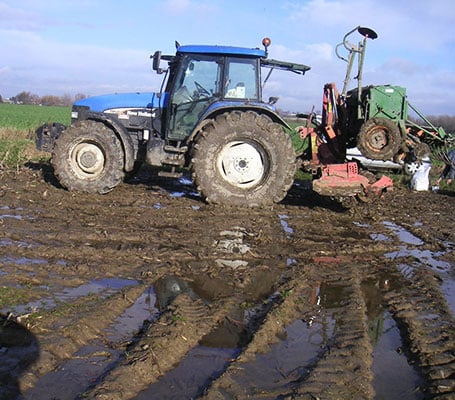
Slippage is necessary in order to do a good job. The ideal slippage rate is thought to be in the region of 12% to 15%.
Normalement, vous devez être en mesure de maîtriser ce taux car le fait de contrôler son taux de patinage apporte les avantages suivants :
- Limiting damage to the ground.
- Reducing working time (optimisation of work efficiency).
- Increasing the lifespan of your tyres (limiting wear to the lugs).
By opting for low-pressure IF tyres, you reduce the slippage rate, because these new generation tyres allow you to work at a very low inflation pressure. This means that you increase the contact patch with the ground while reducing the pressure exerted, thus mechanically reducing the slippage rate.
4. Tyres that will allow you to reduce your fuel consumption
As your fuel consumption represents a recurrent charge that will impact your profitability directly, any optimisation is worthwhile to make savings and to limit your expenses.
If you opt for standard tyres, you will have to adapt tyre pressure depending on the type of ground on which you work, which takes a lot of time, given that the inflation pressure at which you work has a big impact on your fuel consumption.
If you work with overinflated tyres to cater for heavy implements for example, the tyres will sink deeper into the ground, the slippage rate will be higher, thus requiring more engine power to compensate for the higher rolling resistance. This type of situation can lead to extra fuel consumption equivalent to the value of a set of front or rear tyres at the end of the year.
Equipping your agricultural vehicle with low-pressure IF tyres will allow you to bear up to 20% more load than standard tyres, while working at a very low inflation pressure.
5. The quality of your tyres may contribute to soil preservation
Your crops need aerated soil to develop and unfortunately the repeated passage of your machinery can result in excessive compaction, especially if you work with poor quality tyres which can have an impact on the compaction of your soils and their productivity in the long term.
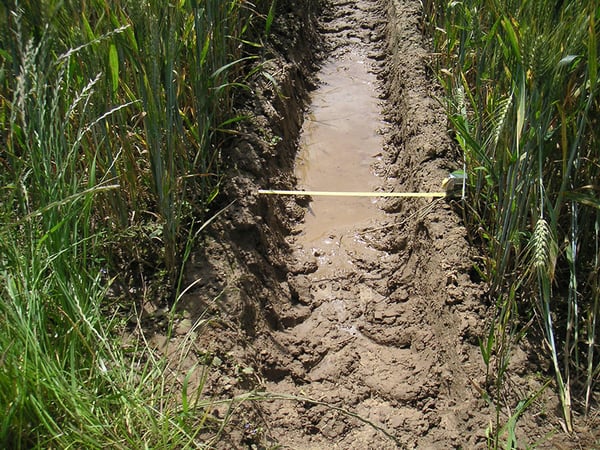 Soil compaction linked to the repeated passage of tractor tyres
Soil compaction linked to the repeated passage of tractor tyres
To preserve your soils, it is highly recommended that you work permanently with low-pressure tyres on all your agricultural machinery.
IF tyres have an extensive flexion and deflection capacity thanks to their supple sidewalls, they can be used at a pressure of 0.8 bar in the fields without any risk of damage to their internal structure.
Using wider tyres with a higher volume of air allows you to spread the weight over a larger contact area with the ground, thus avoiding soil compaction and preserving biodiversity and the root system of your crops.
For more information on tractor tyres
With Firestone, you have the guarantee of tractor tyres that deliver a real advantage, and that in choosing our brand, you can work worry-free.
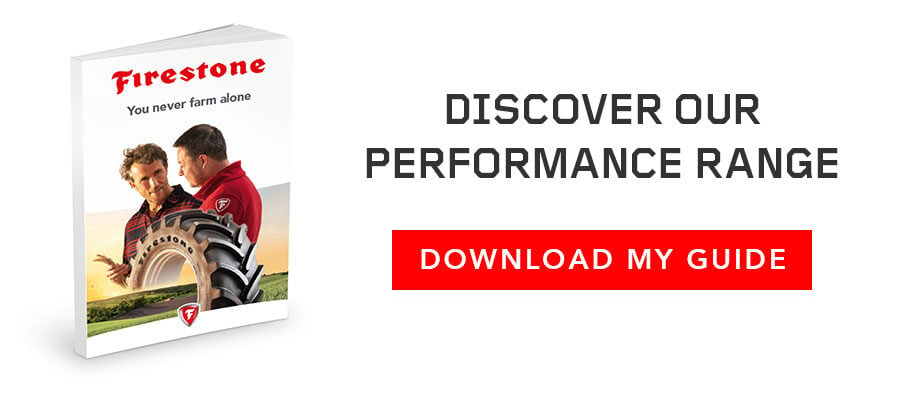
Most people who read this article have also read some of the following articles:
This information is intended only to make you aware of the technical and functional aspects of agricultural tires and their use. It does not allow you to make a judgment or a definitive conclusion on a given problem. Only your agricultural tire expert is able to make a technical assessment and take a final decision, case by case.